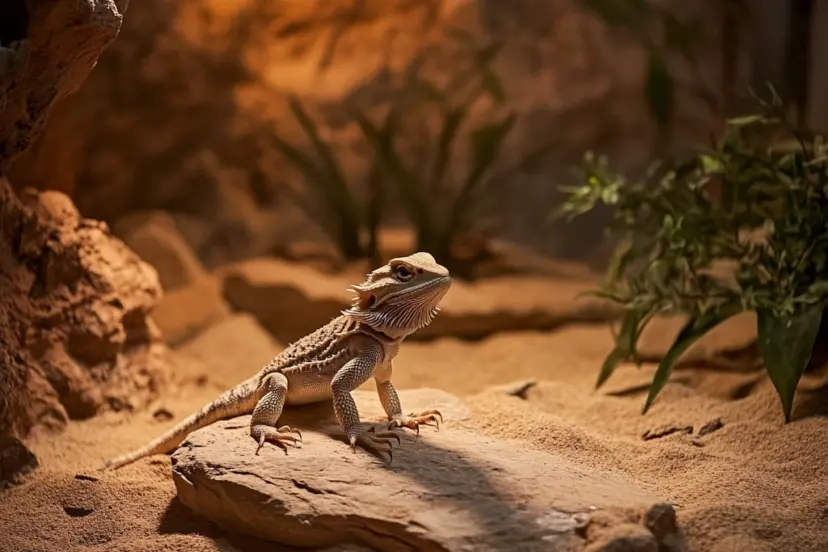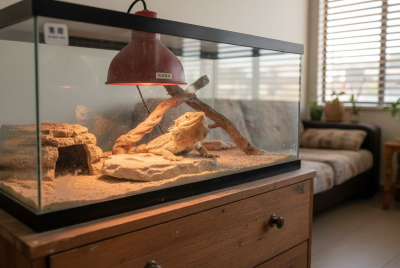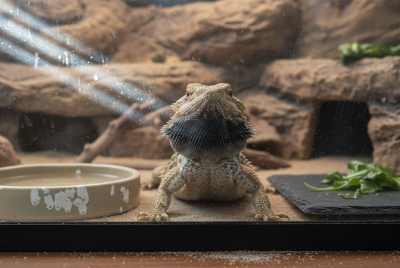Bearded Dragon Pooping: Understanding Healthy and Unhealthy Signs
If you’re a bearded dragon owner, you know that monitoring your pet’s health can sometimes be as simple as watching their poop. Yes, you heard that right! Your bearded dragon’s poop tells you a lot about their well-being. In this guide, I’ll help you understand what healthy bearded dragon poop looks like and when you should be concerned about their bowel movements. Let’s dive into the world of dragon droppings!
Why Monitoring Your Dragon’s Poop Is Important
As strange as it sounds, one of the easiest ways to gauge your bearded dragon’s health is by keeping an eye on their poop. The color, texture, and frequency of their bowel movements can tell you if they’re getting the right diet, if they’re stressed, or if there’s an underlying health issue like parasites or impaction. By understanding what’s normal and what’s not, you can catch potential problems early and keep your dragon happy and healthy.
What Is Considered Normal Bearded Dragon Poop?
Before we get into unhealthy signs, let’s talk about what healthy bearded dragon poop looks like.
Color and Texture: What Healthy Poop Looks Like
Healthy bearded dragon poop should be a combination of two main components: brown solid waste and a white urate (a solid form of urine, as reptiles don’t produce liquid urine). The poop should be well-formed, soft but firm, with the white part being slightly softer. It shouldn’t have an overly strong odor, though some smell is normal.
Frequency of Bowel Movements
The frequency of your dragon’s poop will depend on their age and diet. Juveniles can poop several times a day due to their high-protein diet of insects, while adults, especially those eating more vegetables, may only poop a few times a week. The key is consistency. If your dragon’s poop schedule changes dramatically, it could indicate a problem.
Understanding the Different Colors of Bearded Dragon Poop
The color of your dragon’s poop can change based on their diet or health status. Here’s a breakdown of what different colors could mean:
Brown and White: The Ideal Color Combo
Brown poop with a white urate is the gold standard for healthy bearded dragon poop. This indicates that your dragon is well-hydrated and digesting their food properly. The brown part is the digested food, and the white part is the solid uric acid.
Green Poop: Diet or Health Issue?
Green poop is common if your bearded dragon recently ate a lot of greens or vegetables, especially leafy greens like kale or collard greens. However, if there’s no dietary explanation, it could indicate an underlying issue such as parasites or liver problems. Keep an eye on how long the green poop persists.
Yellow Poop: What It Means
Yellow poop may be due to excess calcium supplements or something in their diet. However, it can also indicate liver issues or dehydration. If you notice yellow poop repeatedly, it’s a good idea to consult a vet.
Black Poop: Indicators of a Problem
Black poop is often a sign of undigested food or too much protein. This can happen if your dragon is eating a lot of insects without balancing it out with vegetables. It could also mean they’re not digesting food properly due to incorrect temperatures in their tank.
Red or Bloody Poop: When to Worry
Seeing red or blood in your dragon’s poop is always a cause for concern. This can be a sign of internal bleeding, parasites, or sharp objects ingested. If you spot blood, it’s time to visit the vet immediately.
Poop Consistency: What’s Normal and What’s Not
The texture of your dragon’s poop is just as important as the color. Here’s what you should watch for:
Firm vs. Runny Poop
Healthy poop should be soft but well-formed. Runny or watery poop can indicate diarrhea, often caused by parasites, diet issues, or even stress. Occasional runny poop after a change in diet is normal, but persistent diarrhea isn’t.
What Constipation Looks Like
If your bearded dragon hasn’t pooped in a while, they could be constipated. Signs include a bloated belly, lethargy, and straining to poop. Constipation can result from dehydration, improper diet, or low tank temperatures.
Diarrhea and What It Could Mean
Diarrhea in bearded dragons can stem from multiple causes: parasites, poor diet, or even stress. If you notice runny stool for more than a day or two, it’s time to take action by reviewing their diet or seeking a vet’s advice.
Factors That Influence Your Dragon’s Bowel Movements
A few key factors directly affect how often and how well your bearded dragon poops.
Diet and Hydration: Key Influences
The most obvious factor is diet. A diet heavy in protein (like insects) can lead to more frequent pooping, while a diet full of leafy greens produces firmer, less frequent stools. Hydration also plays a big role—if your dragon isn’t drinking enough or eating water-rich veggies, they may become constipated.
Temperature and Lighting Effects on Digestion
Bearded dragons rely on external heat to digest their food. If their tank isn’t warm enough (with a basking spot around 95-105°F), they may have trouble digesting their food, leading to constipation or unusual poop consistency.
Stress and Environment Changes
Stress can disrupt your dragon’s bowel movements. Environmental changes like moving to a new tank or changes in lighting, temperature, or handling habits can lead to stress-related diarrhea or constipation.
When to Be Concerned: Signs of Health Issues in Poop
Sometimes, poop changes are more than just a reaction to diet. They can be a sign of a deeper health issue.
Parasites: What to Look For
Parasites like coccidia or pinworms are common in bearded dragons and can cause diarrhea, weight loss, and lethargy. You might notice undigested food or even visible parasites in the stool. A vet can diagnose this with a fecal exam.
Signs of Impaction in Bearded Dragons
Impaction occurs when a dragon eats something that causes a blockage, often from ingesting substrate, large insects, or hard food items. If your dragon is constipated and appears lethargic or bloated, impaction could be the cause.
How to Help Your Bearded Dragon if They’re Having Trouble Pooping
If your dragon is constipated or experiencing diarrhea, here’s what you can do to help:
Remedies for Constipation
Try giving your dragon a warm bath to help stimulate bowel movements. You can also gently massage their belly. If constipation persists, you may need to adjust their diet by adding more water-rich foods like cucumbers or giving them a tiny bit of unsweetened applesauce.
Addressing Diarrhea and Hydration
If your bearded dragon is experiencing diarrhea, the first step is to ensure they’re properly hydrated. You can offer fresh water or mist their food with water to encourage fluid intake. You should also check their diet—avoid fruits high in sugar, as these can cause runny stools, and instead offer fibrous vegetables like butternut squash or pumpkin to help firm up their stool. If diarrhea persists for more than a day or two, or if you notice lethargy, it’s best to consult a reptile vet to rule out parasites or other underlying health issues.
Preventative Care: Maintaining Healthy Digestion
The best way to ensure healthy pooping is through consistent preventative care. Let’s break down how you can maintain optimal digestive health for your bearded dragon.
Proper Diet for Optimal Bowel Health
A well-balanced diet is the cornerstone of digestive health for bearded dragons. For juveniles, a diet of 70% insects and 30% vegetables is recommended, while adults should shift to 80% vegetables and 20% insects. Always ensure they are eating a variety of leafy greens, squash, and other vegetables alongside insects like crickets or dubia roaches to promote regular bowel movements.
Hydration: Keeping Your Dragon Properly Hydrated
Dehydration can lead to constipation, so it’s essential to keep your dragon well-hydrated. In addition to offering a shallow water dish, mist their greens or lightly mist them during shedding periods. You can also give them occasional baths, which not only keep them hydrated but can also encourage pooping.
Temperature and UVB Lighting
Bearded dragons rely on external heat sources for digestion, so keeping the basking area at around 95-105°F is crucial. Additionally, UVB lighting is essential for calcium absorption, which prevents metabolic bone disease and supports overall health, including their digestive system. Make sure your dragon’s habitat has the correct temperature gradient to allow for efficient digestion.
Conclusion: Keep an Eye on Poop for a Healthy Dragon
Your bearded dragon’s poop is a window into their health. By knowing what normal bowel movements look like, understanding the factors that affect digestion, and spotting the signs of potential issues like diarrhea or constipation, you’ll be well-equipped to keep your dragon happy and healthy. A quick glance at their droppings can save you from bigger health problems down the road, so don’t shy away from paying attention to this important aspect of their care.
FAQs
- How often should my bearded dragon poop?
The frequency depends on age and diet. Juveniles may poop several times a day due to a high-protein diet, while adults may poop just a few times a week. - Why is my bearded dragon’s poop runny?
Runny poop can be caused by diet changes, excess water-rich foods, or parasites. If the diarrhea persists, consult a vet to rule out underlying issues. - What should I do if my bearded dragon hasn’t pooped in days?
If your dragon is constipated, try giving them a warm bath and massaging their belly. You can also offer water-rich foods like cucumbers or a small amount of applesauce to help. - Is green poop in bearded dragons normal?
Green poop can be a result of consuming leafy greens, but if the green color persists without dietary changes, it could indicate parasites or other health problems. - What does blood in my bearded dragon’s poop mean?
Blood in the stool is a serious concern and can indicate internal injuries or parasites. A vet should be consulted immediately if you see blood in your dragon’s poop.
By staying informed and vigilant about your bearded dragon’s bowel movements, you can catch early signs of health issues and ensure your dragon remains vibrant and healthy. Regular monitoring, along with proper diet, hydration, and habitat setup, will keep your scaly friend thriving for years to come!




